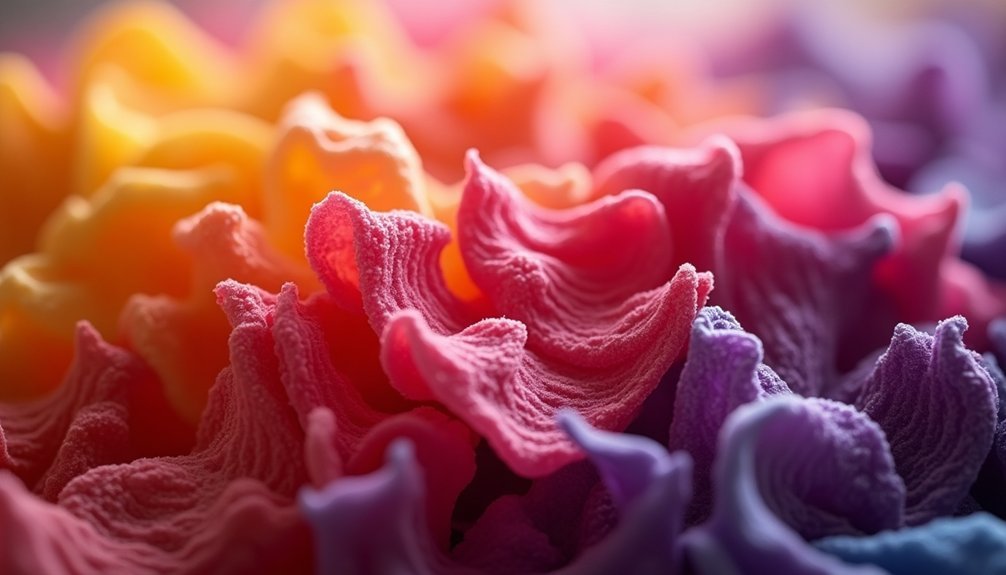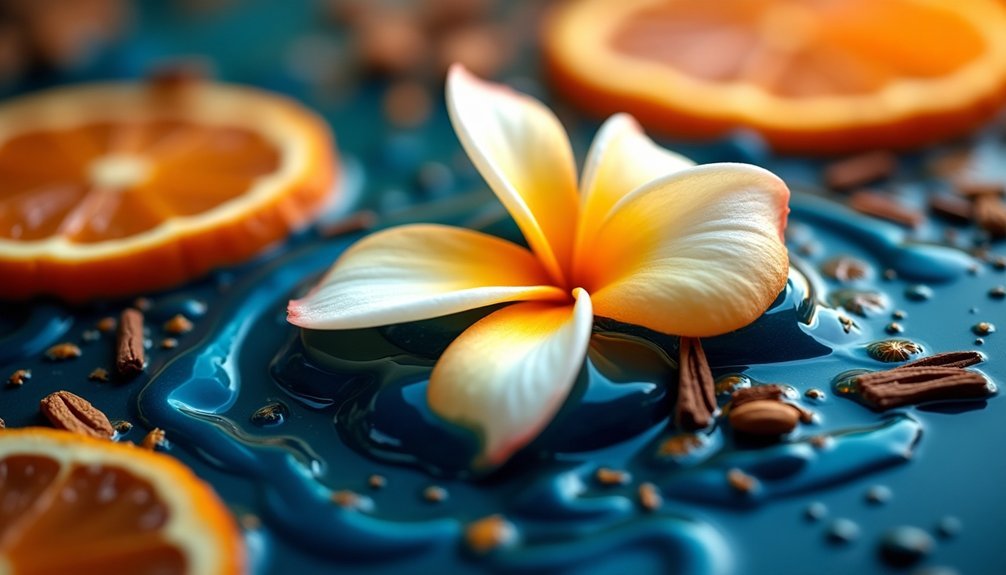When you spray a fragrance, you're witnessing a molecular competition where different scent notes battle for dominance. Lighter molecules create immediate top notes that grab your attention first, while heavier molecules form lasting base notes that emerge later. Your skin chemistry influences how these notes interact and evolve, with some notes complementing each other while others clash. Understanding this intricate dance of competing aromas reveals the true artistry behind perfume creation.
The Battle of Scent Molecules: Understanding Fragrance Competition

When you smell a fragrance, you're witnessing a complex molecular competition unfold in real-time. The battle begins as lighter molecules race to reach your olfactory system first, creating those initial top notes that catch your attention.
Meanwhile, heavier molecules take their time, settling in for a longer-lasting impression as base notes. Your nose becomes the arena where fragrance notes compete based on their molecular weight and volatility.
This competition isn't random – it's a carefully orchestrated dance where each note plays its role in creating depth and character. While some molecules quickly evaporate to deliver immediate impact, others persist, working together or against each other to shape your scent experience.
This molecular interplay explains why fragrances evolve on your skin, revealing different layers as time passes.
Nature's Symphony: How Different Notes Interact in Perfumes
The art of perfumery mirrors a grand orchestra, where each note plays an essential role in creating a harmonious composition. When you experience a perfume, you're witnessing a carefully choreographed dance of scent molecules, each performing their part at precisely the right moment.
Like musicians in perfect harmony, perfume notes dance together to create an enchanting symphony of scents.
- Top notes burst forth like soaring violins, capturing your attention with their bright, fleeting presence.
- Middle notes emerge as the heart of the symphony, adding depth and character like steady cellos.
- Base notes ground the composition like deep bass instruments, ensuring the perfume's lasting presence.
You'll notice how these notes don't simply exist side by side—they interact, blend, and transform. The result is a dynamic olfactory journey where citrus might mingle with florals, or woody elements might complement sweet undertones, creating a unique sensory experience that evolves on your skin.
The Science Behind Olfactory Dominance in Fragrances

Understanding why certain fragrance notes dominate your sensory experience begins with the intricate connection between your nose and brain. When you smell a perfume, your olfactory receptors immediately start processing different molecules, sending signals to your limbic system – the emotional center of your brain.
The competition between fragrance notes occurs naturally due to their varying volatility and concentration levels. You'll notice top notes, like citrus, competing intensely for your attention during the initial application.
As these fade, middle notes emerge in a carefully orchestrated shift. Your personal experiences and cultural background also influence which notes stand out most prominently.
The molecular intensity of specific scents, combined with your brain's emotional connections, determines which fragrance notes will dominate your perception throughout the wearing experience.
Breaking Down Complex Scents: A Layered Analysis
Breaking down a complex fragrance reveals an intricate layering system that competes for your attention throughout the day.
When you first spray a perfume, you'll notice how the top notes include bright, citrusy scents that quickly grab your senses but fade fast. As these dissipate, the middle notes emerge, bringing floral and fruity elements that form the fragrance's core character. Finally, the base notes anchor everything with deep, lasting impressions.
- Perfume Notes work like a symphony, with each layer taking center stage at different times
- Your nose experiences a continuous evolution as notes compete for dominance
- The progression from light to deep creates a dynamic sensory journey
This layered composition guarantees you'll experience different aspects of the fragrance as time passes, making each wear unique and engaging.
The Art of Blending: When Notes Harmonize or Clash

When you're exploring fragrance blending, you'll notice that certain scent combinations naturally complement each other, like the way citrus notes can lift and brighten floral elements.
Your skin chemistry plays an essential role in how these notes interact, as your body's unique pH and temperature can transform even carefully crafted combinations.
While some notes work in perfect harmony, others can clash dramatically, creating an unpleasant discord that might cause one scent to overpower the rest or produce an unwanted fragrance altogether.
Notes That Play Together
The art of fragrance blending resembles a delicate dance between complementary and contrasting notes. When creating your signature scent, you'll find that notes typically work in harmony when they share similar characteristics or create intentional contrasts that smell good together.
The careful selection of compatible notes guarantees each layer unfolds beautifully on your skin.
- Floral and citrus notes create bright, uplifting combinations that feel fresh and energetic
- Sweet gourmand notes paired with spicy or woody elements produce depth and intrigue
- Light, delicate notes balanced with stronger ones create a dynamic yet harmonious experience
Understanding how different notes interact helps you appreciate the complexity of your fragrance. As you wear it throughout the day, you'll notice how these carefully chosen combinations evolve, telling your unique olfactory story.
When Fragrances Fight Back
Although fragrance blending can create magical combinations, not every scent pairing results in harmony. When notes are the building blocks of a fragrance clash, they can create an unpleasant discord that overwhelms your senses.
You'll notice this particularly when incompatible fragrance families collide, such as when spicy elements compete with aquatic notes.
Floral perfumes can be especially tricky to balance, as their delicate nature requires careful consideration of complementary scents. When fragrances fight for dominance, you'll experience jarring shifts between notes rather than a smooth evolution of scent.
This happens when volatile compounds interact poorly, creating chemical dissonance instead of the desired synergy. Understanding these potential conflicts is essential for crafting balanced fragrances that delight rather than disappoint your olfactory experience.
Sensory Overload: Why Some Notes Overshadow Others
When you experience certain fragrances, you'll notice that powerful top notes like citrus and herbs can instantly take over your senses, making it challenging to detect other subtle elements in the perfume.
Your nose's natural tendency to focus on strong, fresh scents creates a competitive environment where multiple potent notes fight for your attention, often resulting in sensory overload.
The chemistry behind this phenomenon involves both the inherent volatility of specific fragrance molecules and how they interact with your olfactory system, leading some notes to dominate while others fade into the background.
Chemistry Behind Note Dominance
Understanding why certain fragrance notes dominate others involves a complex interplay of chemistry and biology. When perfume ingredients interact with your skin, their molecular structure and volatility determine how they'll behave. More volatile notes work quickly to create strong initial impressions, while heavier molecules linger longer on your skin.
- Your body temperature can amplify certain notes while muting others.
- Your skin's pH level transforms how different notes express themselves.
- Your olfactory system's unique response can make specific notes seem more prominent.
The chemistry behind note dominance isn't just about the fragrance itself – it's about how these molecules interact with your personal biochemistry.
As you wear a perfume throughout the day, your body heat and chemistry continue to influence which notes take center stage and which ones fade into the background.
Scent Volatility Impact
Volatile fragrance notes create an intriguing chemical race within your perfume, where lighter molecules sprint ahead while heavier ones lag behind.
When you experience scent volatility in action, you'll notice how citrus and other top notes burst forward immediately, demanding your attention before quickly fading away.
This rapid evaporation can overwhelm your senses, particularly when highly diffusive ingredients like aldehydes are present.
You'll find that these powerful top notes often mask the subtler aspects of your fragrance, preventing you from fully appreciating its complexity.
Your unique skin chemistry adds another layer to this interaction, as it determines how prominently certain notes will emerge.
The key to a well-balanced fragrance lies in managing these competing elements so that each note can shine without overshadowing its companions.
Fragrance Note Intensity Battles
Inside the complex world of fragrance notes, powerful scents often wage an invisible battle for dominance that can overwhelm your senses. When you're experiencing a perfume, stronger fragrance notes can overshadow the more delicate ones, making it difficult for you to appreciate the full complexity of the smell.
- Citrus and spicy notes can quickly flood your olfactory system
- Woody and amber notes persist longer, dominating other scents
- Lighter notes struggle to break through these powerful barriers
This sensory competition isn't just physical – it's psychological too. Your brain naturally gravitates toward the most intense fragrance notes, potentially missing the subtle interplay of gentler scents.
That's why perfumers must carefully balance note intensities to create a harmonious experience, preventing any single component from hijacking your attention and disrupting the intended fragrance journey.
Time-Released Aromas: The Evolution of Competing Notes
When you first spray a fragrance, you're experiencing more than just a pleasant scent – you're witnessing a carefully orchestrated dance of competing aromas. The top notes immediately grab your attention, creating quick emotional responses before gracefully fading to reveal deeper layers beneath.
You'll notice how the fragrance notes evolve throughout the day, as each layer competes for prominence in a precisely timed sequence. The initial bright, volatile notes give way to the heart of the fragrance, while the rich base notes provide a lasting foundation.
This time-released journey isn't random – it's a masterfully crafted progression that keeps you engaged as the scent develops. Understanding this evolution helps you appreciate the artistry behind your favorite fragrances, as each note plays its unique role in the complete olfactory experience.
Chemical Composition: What Makes a Note Stand Out
You'll notice that lighter fragrance molecules create more prominent top notes due to their quick evaporation and competition for your immediate attention.
The molecular weight of a note directly impacts its intensity, with heavier base notes lingering longer but competing less for instant recognition.
Your skin's chemistry interacts uniquely with different volatile compounds, causing certain notes to become more dominant while others fade into the background.
Molecular Weight Affects Intensity
The molecular weight of fragrance compounds plays a crucial role in determining how intensely and how long you'll experience different scent notes.
When you first spray a fragrance, lighter molecules quickly evaporate, creating an immediate impact, while heavier base notes slowly emerge and linger on your skin. This natural competition between molecules creates the evolving symphony of scents you experience.
- Citrus notes burst forth instantly due to their light molecular weight, giving you that fresh initial impression
- Middle notes gradually emerge as the lighter molecules dissipate, creating a balanced shift
- Base notes, with their higher molecular weight, provide the deep, lasting foundation you'll smell hours later
Think of it as a well-orchestrated dance where each molecule takes its turn in the spotlight based on its weight and structure.
Volatile Compounds React Differently
Behind every distinctive fragrance note lies a unique chemical composition that determines its behavior on your skin. When you apply a perfume, you'll notice how volatile compounds interact differently based on their molecular structure.
You'll first detect the lighter top notes, like citrus and florals, as they evaporate quickly and compete for your attention. These fleeting scents dominate your initial perception but fade rapidly.
Meanwhile, heavier base notes, such as musk and amber, take their time to emerge, creating a lasting foundation for the fragrance. The way these fragrance notes interact isn't random – it's a carefully orchestrated dance of chemistry.
Some compounds will naturally overshadow others due to their volatility, while others work together to create a harmonious evolution of scent on your skin.
Testing Fragrance Strength: Methods and Measurements
Understanding fragrance strength requires both scientific measurement and practical testing methods.
You'll find that fragrance strength isn't just about concentration percentages—it's a complex interplay of factors that affect how you experience scents. The fragrance pyramid helps you track how different notes emerge and compete over time, from the initial spritz to the lasting base notes.
- Apply the fragrance to your skin to test how it interacts with your unique body chemistry and observe its evolution over hours
- Use olfactometry with trained panels and electronic sensors to measure precise scent intensity
- Consider environmental factors like temperature and humidity that can alter your perception
Scientific methods combined with personal testing give you the most accurate picture of how strong a fragrance truly is and how its various notes will perform throughout the day.
Master Perfumer Secrets: Balancing Competing Notes
Creating a masterful fragrance goes far beyond simply mixing pleasant scents together. Master perfumers understand that each note in their perfumes must serve a purpose while working harmoniously with others.
| Note Type | Characteristics | Purpose |
|---|---|---|
| Top Notes | Highly volatile | First impression |
| Middle Notes | Moderate longevity | Heart of fragrance |
| Base Notes | Long-lasting | Foundation anchor |
You'll find that the most enthralling perfumes showcase a delicate balance where competing notes enhance rather than overpower each other. Perfumers achieve this through strategic layering techniques and careful consideration of how notes interact with your skin chemistry. They'll combine complementary characteristics while ensuring a smooth shift between different stages of the fragrance's lifecycle. This artful balance creates a unique olfactory journey that evolves beautifully over time, making each wearing experience personal and memorable.
Frequently Asked Questions
What Is the Psychology Behind Fragrance?
Your brain processes fragrances through the limbic system, connecting scents to emotions and memories. You'll experience personal reactions based on past experiences, while certain notes can boost your mood and cognitive performance naturally.
Why Are Perfume Notes Important?
Perfume notes are important because they'll guide you through a complete sensory journey. They help you understand how your fragrance will evolve, from the first spritz to its lasting impression on your skin.
Why Does Perfume Attract People?
Perfume attracts you through its connection to your emotions and memories in your brain's limbic system. You'll find yourself drawn to scents that trigger positive experiences and boost your confidence during social interactions.
What Psychology Says About Perfume?
Your brain's olfactory system directly connects scents to emotions and memories. When you wear perfume, it can boost your confidence, trigger positive feelings, and influence how others perceive you through psychological associations.
In Summary
You'll find that fragrance notes compete naturally due to their molecular structure and volatility rates. When you wear a perfume, these notes vie for your attention as they evaporate at different speeds and interact with your body chemistry. Understanding this competition helps you choose scents that evolve beautifully on your skin, creating a harmonious journey from top notes through to the base.





Leave a Reply